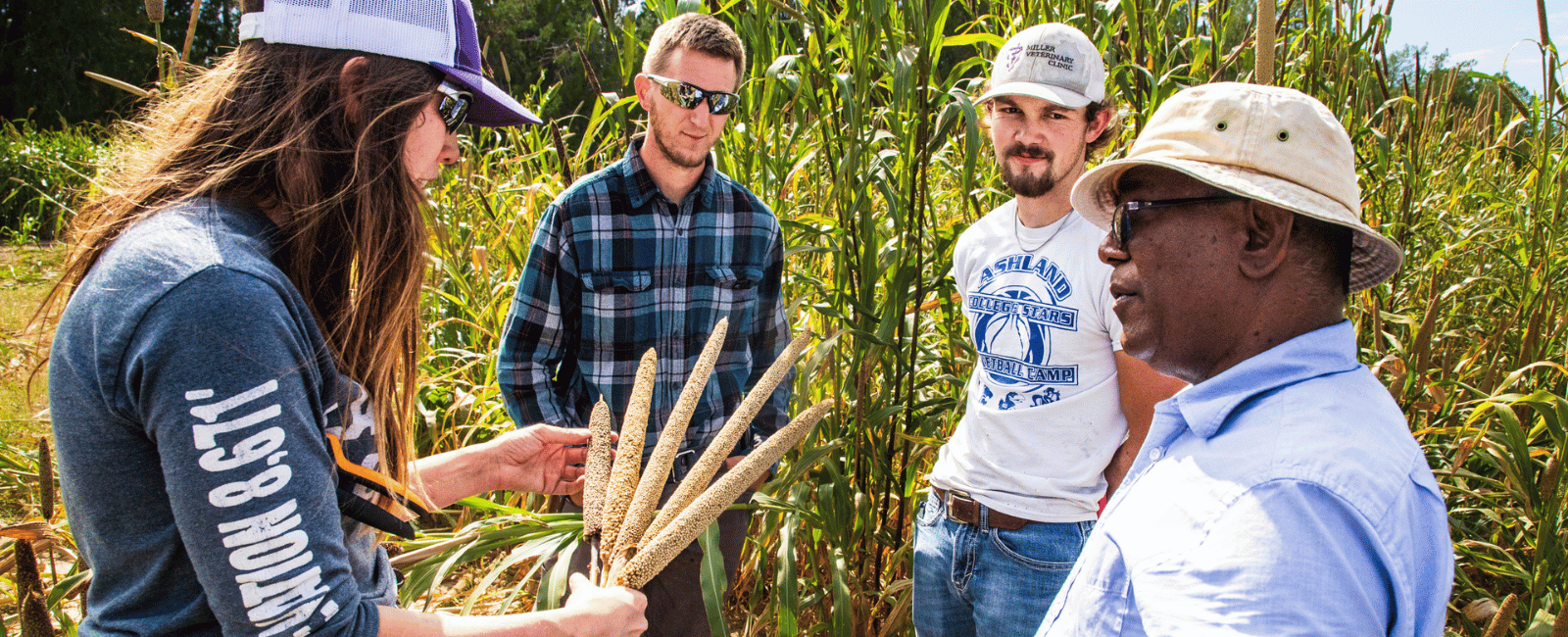
Millet Breeding
Pearl millet research program at KSU Ag Research Center, Hays
Pearl millet (Pennisetum glaucum [L] R. Br.) is a warm season (C-4) annual cereal crop predominantly grown in the arid and semiarid areas of Africa and India. Pearl millet is also grown in the United States in limited areas as a hybrid forage crop and has a high potential to be a commercial grain crop.
Pearl millet research at KSU Agricultural Research Center-Hays was started in 1971 with the goal of developing inbred parents for hybrid development for improved yield and early maturity for the Midwest's short growing season. The program had continued until 1999 and produced several male-sterile lines with their maintainers and inbred restorer lines. The millet breeding program was reinitiated at KSU Agriculture Research Center-Hays with the main goal of developing parental lines for superior hybrids for grain and forage use. The research program focuses on harnessing genetic variability for high genetic yield potential, yield stability, improved drought and high-temperature tolerance, disease resistance, and enhanced nutritional quality, especially micronutrient composition.
To achieve its aforementioned goals the program strives to develop genetically diverse parental lines that will produce high yielding hybrids that withstand drought, high temperature, pests, and diseases. Improved seedling establishment, high tillering capacity, reduced plant height, early maturity, compact heads with bristled ear, large grain with uniform ripening, and good threshability will be targets of selection. The program will work on improving essential micronutrient densities in the grain to enhance nutritional quality for human consumption. High forage yield and improved digestibility will be addressed through breeding for high leaf to stem ratio, stay green and high tillering capacity.
Publications:
- Serba, D., Muleta, K., St. Amand, P., Bernando, A., Bai, G., Perumal, R. and Bashir, E. 2019. Genetic diversity, population structure, and linkage disequilibrium of pearl millet. Plant Genome. 12(3):1-12. https://doi.org/10.3835/plantgenome2018.11.0091.
- Serba, D.D., Yadav, R.S., Varshney, R.K., Gupta, S.K., Govindaraj, M., Srivastava, R., Gupta, R., Perumal, R. and Tesso T.T. 2019. Pearl millet: A resilient crop for arid and semi-arid environments. In Kole, C. (ed.) Genomic designing of climate-smart cereal crops. Springer-Nature, Switzerland.
- Maduraimuthu. D, Perumal, R., Ciampitti1, I.A., Gupta, S.K. and Prasad, P.V.V. 2018. Quantifying pearl millet response to high temperature stress: thresholds, sensitive stages, genetic variability and relative sensitivity of pollen and pistil. Plant Cell Environ. 41(5):993-1007. https://doi.org/10.1111/pce.12931.
- Serba, D.D., Perumal, R., Tesso, TT. And Min, D. 2017. Status of global pearl millet breeding programs and the way forward. Crop Sci. 57:1-15. https://doi.org/10.2135/cropsci2016.11.0936
- Hu, Z., Mbacké, B., Perumal, R., Guèye, M.C., Sy, O., Bouchet, S., Prasad, P. V. V. and Morris, G.P. Population genomics of pearl millet (Pennisetum glaucum(L.) R. Br.): Comparative analysis of global accessions and Senegalese landraces. BMC Genomics. 16:1048. https://doi.org/10.1186/s12864-015-2255-0